
|

|
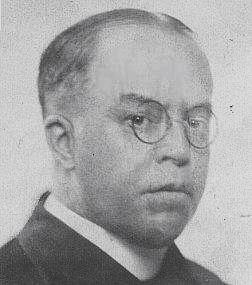
|
| Rev. John Melchior |
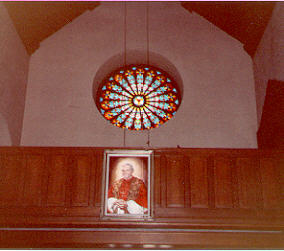
|
| STAINED GLASS WINDOW |
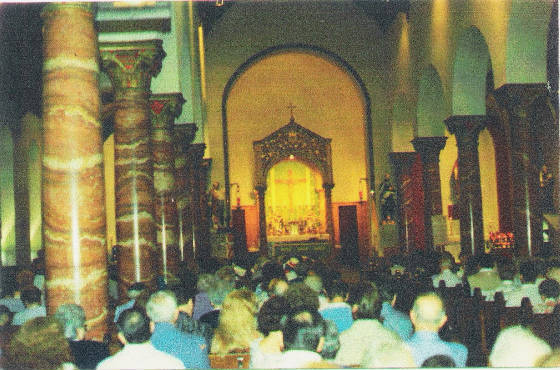
|
| VIEW OF CHURCH INSIDE 1996 |
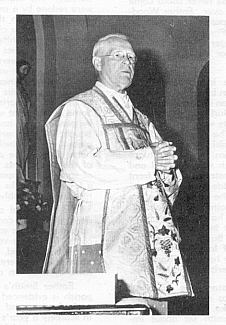
|
| FATHER PHELAN |
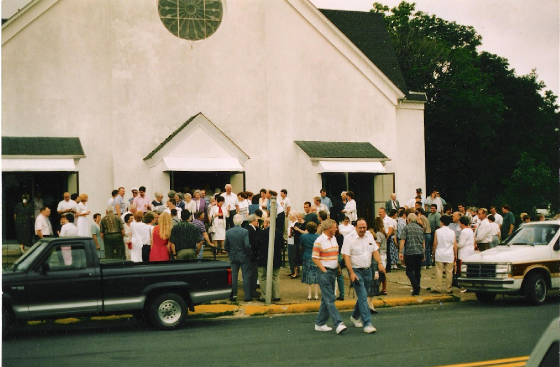
|
| ST. IGNATIUS AFTER MASS |
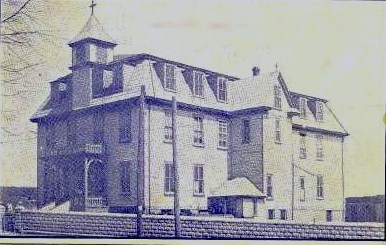
|
| SCHOOL BEFORE REBUILDING |
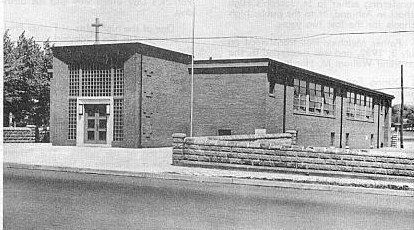
|
| REBUILT SCHOOL |
|

|

|

|

|

|
|
|
The
Rev. Thomas W Hayes was appointed seventh pastor on August 2, 1896. During that time it became
evident that the need existed for a parochial school. Lots were purchased from the Lehigh Valley
Coal and Iron Co. directly across from the church and the construction of the school commenced.
The building was completed late in 1896. It consisted of a large hall for the first floor and eight classrooms on the second floor. There was also a spacious third floor which
was used for storage and a belfry contained a bell which could be heard in every section
of town. The hall was famous for many years throughout the area. In it was held vaudeville
shows and plays early in the century with the entertainment being provided by traveling theatrical
groups.
Later it was used for dances with some of
the big name dance bands in the country playing there.
It was also used for home court for the
Centralia K. K.’s and the Centralia Big Five basketball teams. The hall was mostly used for
parish functions.
With the completion
of the school it became necessary to provide a convent to house the Sisters who were coming to
teach. The convent was erected beside the church with the wood coming from an abandoned breaker
which Father Hayes purchased for the sum of sixty dollars. Having provided both a school and convent. Father Hayes sent a request to his sister, Mother Superior of the Sisters
of the Immaculate Heart of Mary at the West Chester Motherhouse to provide Sisters to teach the
school. Mother Mary Rita and five Sisters came to Centralia late in 1899 and classes were begun.
The original registration consisted of 206 boys and girls. Two weeks later a night school was established
for the boys who spent their daytime hours working in the collieries. The original school building was replaced by a modern school in 1954. (The school was forced
to close in 1981 because of the problems caused by the Centralia mine fire.)
Father Hayes remained
as pastor until July 4, 1907 when he was transferred to Gettsyburg . He was succeeded by
Father Thomas J. Crotty.
Father Crotty was pastor
until 1917 during which time numerous improvements were made to the parish buildings. He also had
the cemetery enlarged and a new organ installed in the church.
TheRev. John Melchior
succeeded Father Crotty and became the ninth Pastor on December 9, 1917. Father Meichior then set
upon the task of starting an extensive renovation project which included most of the parish properties.
The sum of $35,000 was raised through pledges by the parishoners. The church was
extensively renovated both inside and out with the baldachino and two sacristies added to the back
of the church. The church was rededicated on July 22, 1928 by the Most Reverend Phillip R McDevitt,
Bishop of Harrisburg, in a solemn and impressive ceremony.
In August of 1928 an
Old Home Week celebration was held to commemorate the sixtieth anniversary of the inception of
St. Ignatius Parish and to help reduce the debt on the parish.
During Father Melchior's pastorate, a two-year high school was included with the parochial school with the children transferring either to St. Joseph's High School
in Ashland, or to the public high schools for the last two years. Father Melchior was transferred
on July 3, 1932, and was succeeded by the Reverend William M. Horrigan. During Father Horrigans
tenure as pastor, the nation was in the midst of a great depression. All the mines and collieries
in the area were idle and because of the great majority of men in the parish who were unemployed
there could be no reduction of the debt on the parish. Father Horrigan had the old stable near the rectory torn down, and a three car garage erected in its place. Also,
he had the Grotto of Our Lady of Lourdes erected beside the rectory. Because of the depression
he then found it necessary to discontinue the two-year high school but the grammar school was continued.
A fire destroyed the Centralia High School in 1935 and Father Horrigon allowed the students
and teachers of that school to use the parochial school until a new public school was completed
in 1937. Father Horrigan was transferred on April 12, 1936 and was replaced by the Reverend Patrick J. Phelan, who had been pastor of St. James Church, Steelton. Father
Phelan set about immediately to improve the parish properties which had fallen into a state of
disrepair because of the depression. First he had the school reconditioned and interested
members of the borough council to have a new sewer line installed in the vicinity of the parish
buildings. He then had the convent and rectory improved and had new heating plants installed
in each. Father Phelan saw that many men were out of work and he persuaded about fifty of
them to spend their time improving the cemetery. Flooding had been a problem in the cemetery, so he had the men dig a ditch which was then lined with stone and refilled.
This then drained off the water and eliminated the problem.
During his pastorate,
Father Phelan inaugurated the annual Minstrel shows which were held each year on Saint Patrick's
Day which was also his birthday. One of the highlights of Father Phelan’s reign was the Diamond
Jubilee of the parish which was held in 1944. It began on August 28th and continued until September 2nd. It consisted of various events which consisted of a pic- nic, a play entitled
"Lady Spitfire", and a mummers parade. A solemn Pontifical High Mass was celebrated by Bishop
George L. Leech to commemorate the Jubilee. The sermon was preached by Msgr. Charles E. Tighe of
Harrisburg, a native son of the parish. The Priests' Choir of the Diocese of Harrisburg sang at
the Mass. The proceeds of the Diamond Jubilee were $3,200 which was considered to be excellent because at that time the nation was in the midst of the Second World War
and most of the men of the parish were in the service. In May of 1953 the Bishop sent an architect
to inspect the school to decide whether it should be remodeled or replaced. It was then decided
that the old school was unsafe, and plans were drawn up for a new school building.While inspecting
the old school Father Phelan noticed how substantially the basement and the hall floor
were constructed, decided that the new school should be constructed on the hall floor, and have the basement made into a social hall. Razing of the old school began in the
fall of 1953 and construction of the new school was started in early 1954. While the new school
was being built the students and Sisters used four empty classrooms on the top floor of the Centralia
Public School. Later, classes were held in the Convent and Rectory because of a state law which
held that no Catholics studying Christian Doctrine nor teachers wearing Religious attire were permitted in public schools. The general contractor on the school project was the Korbich
Lumber Company of Shamokin and the school was ready for classes in September of 1954.
It contained four large classrooms and principal's office
all in modern design with acoustical ceilings, wardrobes, asphalt tile floors, slate blackboards,
heating and ventilating units. The hall is finished in like manner. Fireproof stairs led
from the front entrance to the school, and the hall and kitchen which are located in
the basement portion of the building has three emergency exits. The entire exterior
is finished with brick veneer. The approach to the front entrance was laid with concrete, and the playgrounds with amesite. The school was dedicated on June 19, 1955. Saint Ignatius School was a building of architectural beauty and is a tribute
to Father Phelan and to the loyalty of its patrons.
On February 10, 1956, Father Phelan was admitted to the Geisinger Hospital
for the removal of a growth which developed after the extraction of a wisdom tooth. Later
he was admitted to the American Oncologic Hospital in Philadelphia for treatments.
He returned home on August 14, 1956 and was met by a caravan of parishioners at the Ashland
station. The following day the children of the parish presented him with a massive reclining
chair. The next day Father Phelan fell in the rectory yard and fractured two ribs which
resulted in his being admitted to the Ashland Hospital for two weeks. After being
discharged from the hospital, Father become quite active again until January of 1957 when
his health began to deteriorate. On February 12 he was admitted to the Geisinger Hospital in Danville, and on March 27, 1957 Father Phelan succumbed to
a cerebral hemorrhage. For thirty one years he had been pastor at Saint Ignatius and his
death instilled a profound sense of grief in all that knew him for he was truly one of the
most outstanding and colorful priests to be found. To do Father Phelan justice in this publication
would be impossible for that would require a volume in itself; but his memory will live
on in the hearts of the people of Saint Ignatius. |
Clickable links
St. Ignatius Church page 1
St. Ignatius page 3
Site index page
|

|

|

|

|

|
|

|

|

